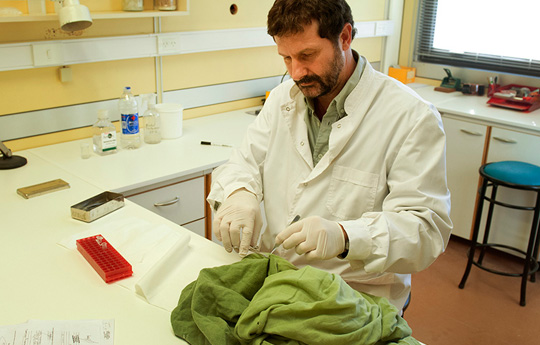CENPAT
Forensic Science: an interdisciplinary contribution to justice
CENPAT professionals provide scientific services for forensic examinations requested by the Ministerio Público Fiscal del Chubut [Public Prosecutor’s Office of the province of Chubut]
Every crime scene has evidence that can lead to the identification of the perpetrator. Although most of it is imperceptible at a simple glance, it can be recovered by specialists working in genetics, anthropology, entomology and archaeology, for instance. And most frequently these disciplines complement one another to interpret evidence.
The Centro Nacional Patagónico [Patagonian National Research Center, CENPAT-CONICET] provides High Level Technological Services (STANs) to the Superior Tribunal de Justicia de la Provincia del Chubut [Court of Justice of the province of Chubut], to the Foro de Superiores Tribunales de Justicia de la Patagonia [Forum of Patagonian Courts of Justice] and other official and private institutions of criminal matters. Services range from parentage analysis and forensic genetics to bioanthropological studies of human remains in forensic contexts that may also include entomological studies, that is to say studies about insects and arthropods associated to corpses.
CONICET independent researcher Néstor Basso is the director of the Laboratorio de Biología Molecular del Centro [Molecular Biology Laboratory of the Centre]. With different methods, they are able to identify and sequence the DNA in blood, semen, skin, saliva or hair, among others.
“We provide the community with a service and contribute to justice by helping to solve cases such as homicides, abuses and disappearances, using DNA to determine parentage and identify the perpetrators of crimes”, the biologist states.
The anthropologists’ work comes into action when investigating cases where complete or fragmentary skeletons are found. The team analyzes human remains in forensic and humanitarian contexts to determine the victim’s biological profile as well as the age of the victim, sex, size and, if possible, cause and approximate time of death.
Silvia Dahinten, CONICET independent researcher and director of the Laboratorio de Antropología Biológica del CENPAT [Laboratory of Biological Anthropology], explains the work process. “The scientific support department of the police collects all the skeletal remains and evidence. Then, these are delivered to the laboratory with all the documentation related to the finding. It is at this point that researchers determine whether those bones are human or not. If they are, the following step is to determine the biological profile and other possible information. Then, the final report with the expert evidence is forwarded to the prosecutor”.
Likewise, the researcher emphasizes the importance of forensic entomology. Ana Paula Armani, CONICET postdoctoral fellow at CENPAT and responsible for the service, describes the discipline as the study of insects and arthropods within forensic contexts. The aim is to obtain information about a death or determine whether the body was transported in homicide cases or suspicious deaths. Furthermore, Armani studies the decomposition of bodies and life cycle of insects in the Patagonia at different times of the year, as it is strongly influenced by temperatures.
“Each environment is characterized by a particular group of insects, and therefore the entomofauna in the Patagonian is different from other places. For this reason, we are conducting a baseline study to know the fauna and its life cycles in the area. Depending on the insects we find in the body and their stage of development, we can calculate for how long it has remained in the body and therefore estimate the date of death”, she states.
For his part, Dahinten remarks the importance of the interaction of different specialists: “archaeologists are in charge of the recovery of skeletal remains. Before producing the inventory of these elements, Armani analyses the entomological fauna and then, at the request of the prosecutor, the genetic study is conducted by Basso”.
The researchers highlight the contribution of the institution as regards the training of human resources in the different branches of forensic science and the training for the policía científica [Scientific Support Department of the Police] to improve sample taking, a crucial stage to conduct subsequent studies. The more accurate the sample, the more precise the scientific estimate.
- By Cecilia Leone
